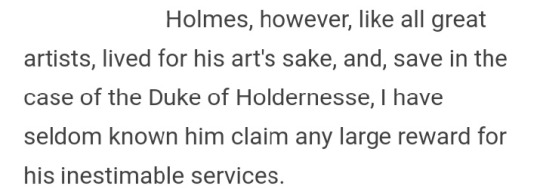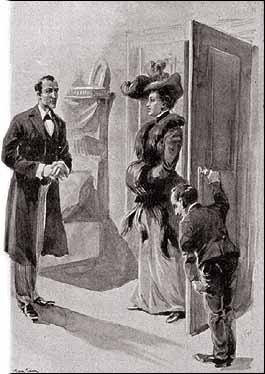#letters from watson spoilers
Text


“…What can I do, Holmes? Of course, it was that damned fellow who set them on. I'll go and thrash the hide off him if you give the word.”
- The Illustrious Client
“You are right,” he cried with an immense sigh of relief. “It is quite superficial.” His face set like flint as he glared at our prisoner, who was sitting up with a dazed face. “By the Lord, it is as well for you. If you had killed Watson, you would not have got out of this room alive."
- The Three Garridebs
Text Parallels here. ID in alt.
#sherlock holmes#john watson#acd holmes#the illustrious client#the three garridebs#my art#link goes to screenshots of the passages from the stories#letters from watson has reached 3garr but I don’t believe illustrious? ->#letters from watson spoilers
957 notes
·
View notes
Text


Parallels
The Illustrious Client & The Three Garridebs
#acd holmes#sherlock holmes#john watson#the illustrious client#the three garridebs#it's the parallels my friend#the very beloved 'hit my friend and I'll hit you back'#'don't look so scared' one of my favorite lines in the whole series#letters from watson has reached 3garr but I don’t believe illustrious? ->#letters from watson spoilers
310 notes
·
View notes
Text
People who nearly succeeded in killing Sherlock Holmes, ranked in descending order of seriousness
Sebastian Moran (The Empty House). The man had enough vendetta to single-handedly keep Holmes out of London for three years, and didn't wait a day past Holmes' return to Baker Street to make good on the threat. Even after all Holmes' elaborate preparation against it, he still would have killed him if Watson weren't in the same room.
Professor Moriarty (The Final Problem). Extremely serious, as we all know. Very nearly did come off a few times over. But... well, there's no doubt it would have come off, had he acted sooner- at any point before Holmes was on Permanent Red Alert and the whole criminal empire was collapsing about his ears. Put him in the ranks of those who tragically overestimated their opponents. If he were not a challenge and a treat but a part of the ordinary course of business, Holmes would certainly be dead.
Culverton Smith (The Dying Detective). Horrid man. Evil design. The plunging feeling in my stomach would vault him to the top of the list if left to its own devices. But he put all his hopes in sending Holmes a prank jewel-box. As there is no reason one would anonymously send Holmes a real jewel-box, that makes the effort a bit less serious.
Tonga (The Sign of Four). This stood a better chance of working. All he lacks is the ability to shoot accurately while on a riverboat, and it's an ugly way to die. But you can't take Tonga seriously. He is a walking extract from the pages of the Encyclopedia of Obscure Racism, and you can't get past that.
Baron Gruner (The Illustrious Client). Responsible for the greatest actual bodily harm Holmes incurs during the series, but not a full-throated murder attempt. He seems to regard a killing, a maiming and a roughing-up as basically interchangeable ideas.
Alec Cunningham (The Reigate Squires). What do you expect to happen after you've strangled Holmes in the next room from an active police inspector, guy? You think you're getting off that murder charge now? Should've used that energy to run like a bunny.
Sherlock Holmes (The Devil's Foot). What. Were. You. Thinking.
Count Sylvius (The Mazarin Stone). The grade of villainous plot I expect from a literal cartoon.
366 notes
·
View notes
Text

See this bit confused the absolute crap out of me when I was trying to gather dates for my chronology--
Because Watson sets up this paragraph talking about 'Things Holmes Did In 1895', but this is a reference to The Priory School, which cannot occur earlier than 1901.
So after being confused for a good twenty minutes, I looked again at the publication order and swore a bit -- because we won't get that story for ages, but this is a callback to the previous month's story.
So yeah. That's who the Duke of Holdernesse is. He's a guy Holmes and Watson won't meet for a minimum of six years, that Watson can only reference because these stories are written in retrospect.
#sherlock holmes#letters from watson#black peter#the priory school#letters from watson spoilers#i reject your chronology and substitute my own#so yeah this is watson saying#''except for the story i told you last month where he took the victorian equivalent of a half a million quid for his services--''#(actually it was over £1.2m but that was split 50/50 with watson)#(all into holmes's account though)
33 notes
·
View notes
Text

Straight from Google Maps and with a reckless disregard for research or nuance, here is my very rough representation of what Holmes apparently got up to during the Hiatus.
...He covered a lot of ground.
He also offered NO elaboration on his route between Florence and Tibet, so? who knows how he actually got there?? I just pulled up his stated locations and played connect-the-dots. Ditto for Khartoum -> Montpellier—he could have crossed the Mediterranean at basically any point, as far as I can tell. I drew a line through Africa because that was fresh ground.
#i think about this every so often when trying to determine where you could plausibly set Hiatus Adventures#the answer is...almost anywhere apparently#letters from watson spoilers#sherlock holmes
26 notes
·
View notes
Text
Okay can I just say. These Victorian people are like fainting goats: they play dead as soon as something slightly confusing or embarrassing happens to them.
#letters from watson#letters from watson spoilers#the man with the twisted lip#the man with the twisted lip spoilers#the noble bachelor#the noble bachelor spoilers#Sherlock Holmes#Sherlock Holmes spoilers#fainting goats#social anxiety
33 notes
·
View notes
Text
Ferguson: So what do you do if you think your wife is a vampire? Asking for a friend…
Jonathan Harker: Easy! Just let her turn you into a vampire too and face damnation together.
Ferguson: What
Jonathan: What
58 notes
·
View notes
Text
SO okay there are well over a dozen different chronologies of Sherlock Holmes out there, in paper books and all that.
But, because Sir Arthur Conan Doyle gave negative fucks about anything to do with Sherlock Holmes continuity, if you are going to make a Definitive Chronology you have to make a bunch of decisions about things like "There are not only eight weeks between April 27 and October 9" and "This one is dated to the timeframe when Holmes was *dead*" and "This one has no indication of the date or year at all".
This gets even more complicated by the fact that many of the attempts at a definitive chronology are done by people who were playing "The Great Game", that is, pretending all their scholarship is based on the assumption that Watson is a real person and everything detailed in the stories really happened, so you can only have Watsonian explanations for all the conflicts instead of the simple and sweeping "Doyle did not give one single shit".
(There are also chronologies based on theses varying from "Watson is a time traveler" to "All the continuity errors are covering up H/W shippiness: the worse the error, the gayer the secret". It's a fun romp if you don't take it too seriously.)
What I've done in this Gdoc, which I hope people will feel free to use and base their own chronologies on, is I've copied out every date that is given in the Complete Sherlock Holmes and put them in order, along with the dates we can deduce by "three weeks earlier", "four years later", and so forth. When this causes conflicts, I have noted the sources and details, so that hopefully people can make their own decisions.
(1169 pages of hardcopy reviewed in three days. I may not have the ADHD, but I can definitely get head-down on a project.)
Have fun!
#letters from watson#lettersfromwatson#sherlock holmes#watsonian chronology#sherlock holmes spoilers#i guess?
203 notes
·
View notes
Text
I'm reading Letters from Dr. Watson this year, and let me tell you, so far I've been thoroughly amused. The most recent work has, in no particular order:
Called the landed gentry of England morons, repeatedly.
Involved Holmes following a literal treasure map.
Made the criminal pull double duty as the victim.
Had said criminal murdered because he treated a woman (extremely) poorly.
Let said woman get off scot-free with the murder and escape the place that treated her poorly.
Had the explicit moral that your actions against other people have consequences. Yes, even your actions against women, because, and this may be shocking, women are people.
All of the above relayed by Holmes to Dr. Watson in a way that I can only describe as someone trying to show off for someone, fail to do so with any subtlety, and then manage to still impress because the thing they're showing off really is that impressive and also the target likes them already anyways.
Dr. Watson also transcribes that all, verbatim, to me in his email talking about his weird flatmate in a way that makes it pretty clear that, romantically or platonically, he thinks they hung the stars and moon.
This is great, I'm telling you, and it's even greater that Arthur Conan Doyle would be rolling in his grave if he knew how much enjoyment I'm getting out of his books in the good year of 2023
160 notes
·
View notes
Text
dying detective #1 on my list of "jail for holmes for ten thousand years" stories. oh so you think a woman's friends should beat the man who deceives and plays with her feelings do you? well girl i am watson's friend and i am going to beat YOU
39 notes
·
View notes
Text
Does anyone know the reasoning and logic behind today being Sherlock Holmes’s supposed birthday? I’ve been googling but can’t find the actual reasoning and I need to know!
#letters from watson#i've read them all before so if there are any spoilers in the explanation i would still be glad to hear
56 notes
·
View notes
Text




As he spoke there was a tap at the door, and the boy in buttons entered to announce Miss Mary Sutherland, while the lady herself loomed behind his small black figure like a full-sailed merchant-man behind a tiny pilot boat. Sherlock Holmes welcomed her with the easy courtesy for which he was remarkable...
Miss Mary Sutherland, drawn by Sidney Paget, Josef Friedrich, Martin Van Maële, and Gastão Simões da Fonseca, respectively
Source
#letters from watson#a case of identity#mary sutherland#sherlock holmes#art#sidney paget#josef friedrich#martin van maële#gastão simões da fonseca#got curious and looked up some pictures#there are more if you look into the source#spoiler warning I suppose#its interesting looking at the different interpretations#from different artists
44 notes
·
View notes
Text
Letters from Watson: The Man with the Twisted Lip
Crimes in Context.
Sit down bloggers, it's time for a few rounds with my current least-favorite monetary system, and an actual scale of the wealth difference between the poorest and wealthiest Victorians. I already did some math here, where @thethirdromana did some research regarding other contemporary math failures about begging. I swear this will be interesting after we get through the math.
Imperial Currency Definitions
Pound, or "quid" or "pound sterling": Literally one pound of silver coins. (Sterling is a silver alloy.) The gold coin representing it was called a Sovereign. It's worth 240 pennies or 20 shillings. There was also a gold half-sovereign. (120 pennies, 10 shillings...)
Shilling: 1/20th of a pound. A silver coin.
Penny also pence, but only as a plural: 1/240th of a pound, or 1/12th of a shilling. Confusingly, there were silver pennies, copper pennies, and bronze pennies, with the exact same value, during the 1800's - silver pennies were minted specifically for royal charity, to be given out on Maundy Thursday. (The day before Good Friday.)
A lot of victorian accounts are written in Pounds, shillings, pennies, represented as L/s/d, but there were also other coins. I do not like them any better than this setup, but they provide context, so here we go.
Guinea: One pound and one shilling. Not it's own coin by the 1890's, since the last ones were minted in 1814, probably because they're stupid. I've seen it cited that if a professional gentleman was paid a guinea he got the pound and his clerks or assistants got the shilling.
Crown: Five shillings / a quarter pound. Represented by a silver coin.
Sixpence / Fourpence (Groat) / threepence / twopence (half-groat): conveniently, the numbers within the name tell you all you need to know. These were silver but twopence was also only minted for Maundy money during this era.
Halfpenny / Ha'penny: Half a penny, a bronze coin.
Farthing: A quarter of a penny, also a bronze coin, presumably for transactions like buying a single egg or leaving an extremely insulting tip.
Typical Wages:
Poverty:
Laborers and factory workers may get anything from 4 shillings (0.2 pounds) to 1 pound per week. Women and children were routinely paid much less for the same work as men. Francis Moulton's 8s room from The Noble Bachelor cost up to two weeks wages per night. If an average adult male working in a factory was paid about 1 pound per week, he would make about 50-52 pounds per year. If a maid was paid 4 shillings a week, she would make about 10 pounds a year. If a child was paid 1 shilling a week, they would make about two and a half pounds a year. My sources cited a variety of years from 1860 on, so take all of these as ballpark estimates.
The difference between 10 pounds and 50 pounds per year doesn't sound that stark, but today it's the equivalent of 1,000 pounds (1,200 USD) and 5,000 pounds (6,000 USD). Neither is enough to live on now, and it wasn't enough to live independently then, but it's the difference between living on L 2.7 / USD 3.2 a day and L 13.7 / USD 16.4 per day: You starve a lot faster at that first rate.
(Obligatory note that live in servants often had it better than factory workers making the same wage on account of having room and board provided as part of their compensation. Hence why a governess - a gentlewoman in distress - considers L50 a year a fairly comfortable wage: she's not paying rent, or for the bulk of her food. Like today's population of new graduates teaching English abroad.)
Comparative Wealth:
Neville St. Clair states he's making about L 700 a year by begging. This is the equivalent of 71,000 pounds / 85,200 USD today. It's about the same salary as a modern university chairperson. At the time of this story it's enough to live in an upper middle class suburb very securely, with several servants. It is, however, an absolute bullshit number. To acquire five hundred and sixty six (ish) pennies per day, in 691 coins, St Clair probably had upwards of five hundred people toss him a coin. Presuming that the reason nobody gave him twopence was low circulation of that specific coin, we can estimate that few, if any, people gave him three pence or more, judging by a lack of any of three pence, four pence, or sixpence coins. (There also aren't any farthings but I'm not sure what 0.25 pennies could actually buy you in those days. Possibly people who had any money to spare didn't carry them.)
If Neville works his corner for just long enough to get home by the 5:15 train, and it takes him maybe ten minutes to change out of his disguise, it's a reasonable assumption that he leaves his corner by 4:30 ish. He isn't noted as leaving particularly early in the mornings either, so I'm going to roughly estimate that he works about eight hours a day. If so he is earning more than a penny per MINUTE begging. He's getting someone throwing him a penny every 55ish seconds. There's a line of his benefactors dropping coins into his hat.
Threadneedle street was home to the Bank of England and the London Stock Exchange: presumably St. Clair picked this location because people going to and from either actually had some money to spare. But it also leads to an inevitable alternate idea: since it's impossible for St. Clair to be regularly making two pounds a day begging, perhaps his beggar disguise is for more criminal reasons... perhaps a long running plot to rob the bank? Either he is casing the place or he's a lookout. Or perhaps he's the accomplice of a clerk skimming his own pound or two a day out of the change from deposits, handing it over to St. Clair whenever he walks out for lunch or at the end of his day so that he's never discovered with a truly stupid amount of pennies.
And as far as Holmes is concerned... he's brilliantly deduced the bizarre portion of this case. Who cares that the scale of the begging is impossible? The Victorian middle class could be just as blinded by propaganda regarding the poor as we can be today. Even though there were no official public services and the myth of the welfare queen is a modern invention there were definitely people who resented the entire idea of charity: human nature has not completely changed in the last 130 years.
#Crimes in Context#Letters from Watson#The Man with the Twisted Lip#This wouldn't count as fictionalization as Watson wouldn't know#but it makes slightly more sense than St Clair's story being actually accurate#No I did not purposefully make it so that the two stories who reference red hair contain potential bank robbing#spoilers#Spoilers for the Red Headed League
25 notes
·
View notes
Text
So as I recall, this story is one of the ones where Holmes Fucks Up Majorly, and also where the Big Reveal(tm) is spoiled by modern common knowledge as compared to that of audiences in the 1890s.
58 notes
·
View notes
Text
Opening my email today: Oh I see Sherlock Holmes is dead. How sad.
#letters from watson spoilers#is that a thing? i don't know#i'm mostly not getting around to reading the emails i have to admit#but i do like knowing what point they've gotten to
14 notes
·
View notes
Text

.........whaaaaat do we think men do when their house is on fire??
20 notes
·
View notes